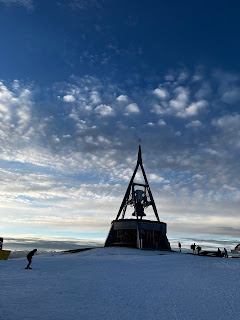As for every trip, I had checked the website of the German foreign office to get information on Panama and Costa Rica. Write ups for both countries emphasised the importance of getting the exit stamp from Panama and the entry stamp from Costa Rica. So I searched and found two travel blogs explaining the process including photos for every step. So I felt ready to do it and let's be honest that's not my first border crossing by road.
Two years ago, I traveled by bus from Croatia to Bosnia-Herzegovina. We stopped at the Croatian side, got out of the bus, lined up, got our passports checked (and stamped). Boarded the bus, drove across the border, stopped on Bosnian side, got out of the bus, lined up, got our passports checked and stamped. And officially entered Bosnia-Herzegovina.
Back to Panama, I arrived by Uber at the border in Paso Canoas. I found the building from the first steps of the blogs. I found the customs office and Panama Entry but not Panama Exit. The lady at the entry desk told me the exit is 5 km away. My answer: that does not seem logic.
Step 1: Exit Panama (that was the theory)
Outside of the building several taxi driver offered me their services to the 5km away location including return trip for 15 USD. I was like I want to go to Costa Rica, not come back. I agreed with one driver to take me to the border center for 6 USD. When we reached there, he again made the 15 USD offer and I declined.
This very new Centro de Control Integrado is a shared building for Panama and Costa Rica, where you exit one country and enter the next in a single flow. I entered, I was the only foreigner there and got a Malaria test done - apparently they only had 4 cases in all of 2024 - so the chance of them calling you are pretty low. Then I went to the first row of desks and got my exit stamp for Panama. At the second row, I got my entry stamp for Costa Rica after answering some questions and providing my flight ticket to leave the country in two weeks. Last was the customs check. All in all, I was done in 10 min or less.
Aerial view of the new border center
The security guard at the other end of the building opened the door and asked me where my taxi is. I said I did not have one, so he showed me the way over the foot bridge to the main road. I had hoped there would be some Costa Rican taxis or that I could book an Uber to pick me up. Good idea but with no connection in the no man's land between the two countries, I was kind of stranded.
The exit to Costa Rica
So I rolled my suitcase (about 25 kg) along side the road (Panamericana) for 2.5 km to the next local bus stop. Luckily, it was around 9:30 in the morning, the road was busy but not so busy that they would run me over. At the bus stop (without any schedule), two elderly ladies were already sitting and waiting and told me the bus would come in 10-15 min. When it arrived, I paid my 1 USD fare as I did not yet come across an ATM.
I'm walking - down the street - I'm walking
Not my bus stop but a similar one
So what did I learn - I can be stubborn. There is probably a deal between the taxi drivers and the border center and the bus company. Otherwise, why did no-one created a new bus stop at the center when they opened it. Make sure to take water on your adventures - I drained one or two bottles on my walk.
If you want to skip the walk, pay the 15 USD, go back to Paso Canoas and take the long distance/ regional or local bus that crosses the border to Costa Rica (but does not stop at the border center).
I definitely have another great story for my travelogue.

















































